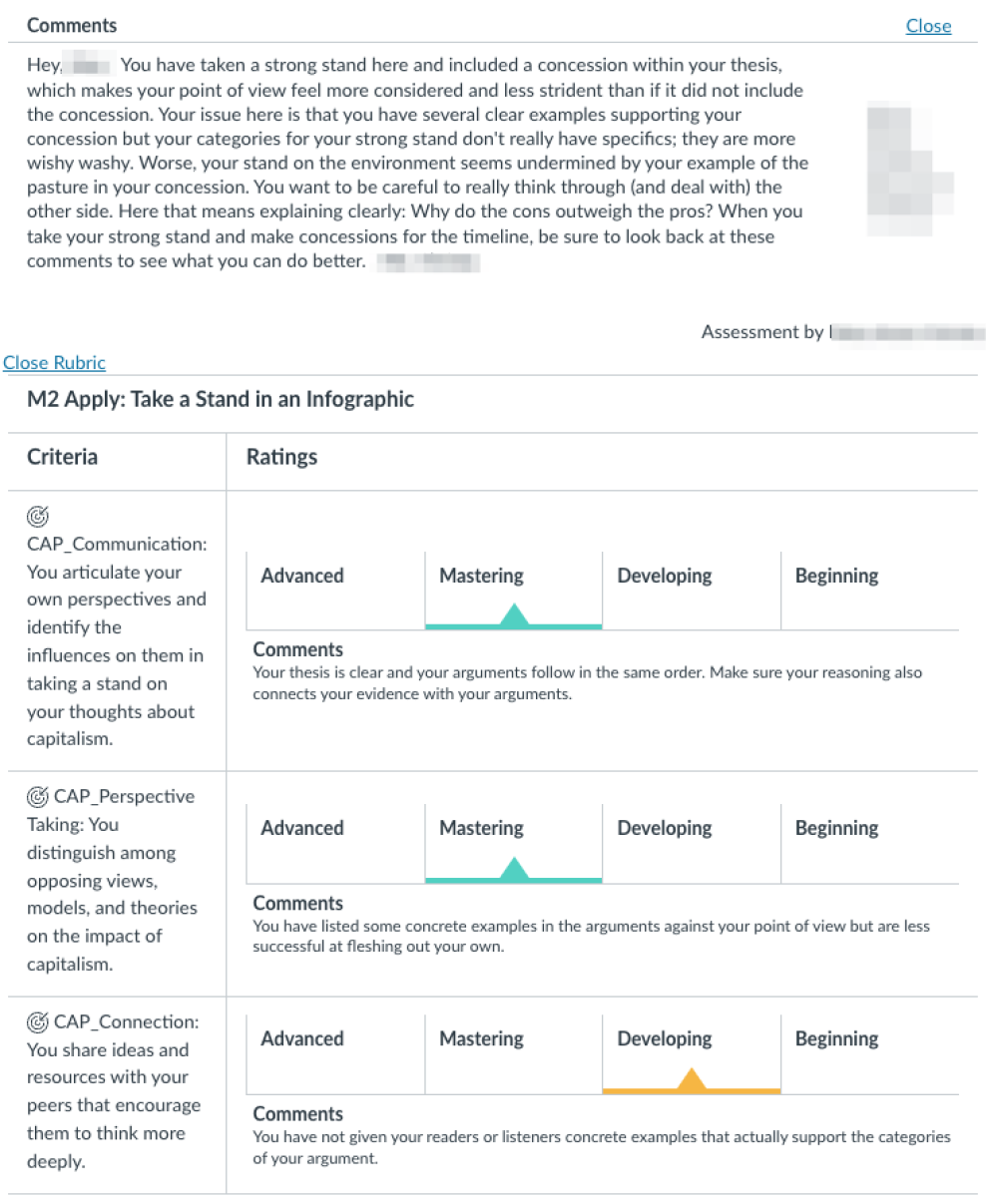How We Grade and Why
In 2022, we published a blog post on how we have worked to fuse competency-based learning (CBL) with our constituents’ need for conventional grades. There is a lot of interest in this particular topic as many school leaders find agency, equity and transfer - the tenets of competency-based learning (CBL) - to be extremely compelling goals, and yet the how of change management, particularly with respect to grading and reporting, is challenging to say the least. Now, two years later, I wanted to revisit how we grade and why, reflecting on what has evolved and how our practices have deepened. The core principles of agency, equity, and transfer remain central to our approach, guiding our ongoing efforts to refine grading and assessment.
Agency
In 2022, we wrote about our move away from assignment level grades, toward an ecosystem of feedback aligned to competencies and outcomes. This work has been very successful by any measure. The redacted rubric below is a good example from an essay assignment in a new course, Capitalism: Past, Present and Future. The student receives a holistic comment on his work as well as comments specifically aligned to the learning outcomes in question. However, there is no B+ at the top of the assignment. The feedback stands alone, so that the conversation between the teacher and student moves from “Why did I get a B+ and not an A-?” to “What can I do to improve how I share ideas and resources with peers?” As we’ve discussed elsewhere, these proficiency ratings are associated with numeric values on the backend, which roll up into competency grades that are updated every 12 hours according to the new inputs coming in from rubrics. Here is the video explainer that we use with our students.

We create the grade reports entirely from these rubric assessments, separating academic skills from behaviors (which is an important part of grading for equity at GOA, as we’ll see in a moment). We believe that students’ grades should communicate what they know and can do vis-à-vis the competencies and outcomes that the course and the teacher are hoping they’ll take away. Behaviors like punctuality, class participation, assignment completion and other class compliance requests are important areas where students need ongoing coaching, but if these are not among the articulated goals of the course, that coaching is separate and apart from the realm of grading at GOA. In the past two school years we have had a 70% assignment completion rate threshold. In other words, as long as a student completed 70% of their assignments, their grades would be entirely driven by the outcome-based assessments on their rubrics. And while the average GOA student has completed 92% of their assignments during these two years, we have learned that there is a polarity to be managed between allowing students a lot of agency around which assignments they complete, how many they complete and when they complete them and allowing them so much agency that their approaches to learning don’t make for an engaged member of the classroom community.
Our revised approach in 2024-2025 maintains our commitment to keeping a clear separation in grading between behaviors and the competency goals of the course, while recognizing that an engaged member of a learning community needs to do more than simply submit a minimum number of assignments. Without going too deep into the weeds, in shifting from our very simple 70% Assignment Completion Rate (ACR) threshold to a more nuanced 70% Engagement Score threshold (which can include punctuality and other behaviors), we are raising the bar on expectations around how learners show up for one another in our learning communities. In order to earn the privilege of participating in a high-agency, high-trust, competency-based learning environment, teachers and students need to show up fully for one another. We expect that this revised approach to how we communicate with students about the balance between agency and the behaviors related to building and participating in a learning community, will strengthen our students’ experiences going forward.
Equity
Equity is the second pillar of CBL at GOA. As we have written in the past, and as we discussed briefly above, a big part of GOA’s approach to grading for equity is about basing our grades entirely on the degree to which the teacher sees evidence of competency mastery in the work that the students submit. In other words, as Gusky, Feldman and others have shown, when a student fails to submit an assignment (for example), recording a punitive 0 clouds the accuracy of our grades and has a disproportionately negative impact on students from historically marginalized communities. We have remained committed to avoiding using grades as carrots or sticks to create compliant behavior. Instead we use grading approaches that are focused on the competency goals of the course, and that weigh the students’ most recent work more heavily than what is achieved by using pure averages (as most traditional approaches do).
Regarding equity, I want to dwell for a moment on an area where the development of artificial intelligence (AI) technologies have allowed us to take our commitment to facilitating norming and cross-marking assignments a step further. One of the results of our CBL ecosystem is that we have access to tens of thousands of rows of relatively clean assessment data that can be exported from Canvas LMS and analyzed. In years past, that data set was so unwieldy as to be very difficult for us to get our heads around. As a result, it seldom resulted in concrete action items. In the past twelve months, however, we have been able to anonymize that data and leverage AI tools to garner helpful insights into equitable assessment.
For example, because of the cleanliness of our CBL assessment data, at the end of a semester, we can furnish our teams with data that tells them which outcomes were assessed in their courses, how many times per student they were assessed, and what the distribution of Advanced, Mastering, Developing and Beginning ratings was by course and by teacher. This data opens the door to impactful conversations between and among teachers when they realize that they have solid shared expectations on one learning outcome, but that their assessments vary significantly on another. Similarly, when teachers realize that they assessed one outcome 10 times throughout the semester, and another outcome only twice, it’s time to have a discussion about either adjusting the curriculum or the learning outcomes targeted in the course. This is work that we’re able to do, in large part, because we have consistent competencies and outcomes used across sections, and a consistent approach to using rubrics for grading and assessment. In short, our teachers give up a little bit of autonomy in order to enable a truly collaborative, schoolwide approach to high-quality, equitable grading and assessment. Spoiler alert: There is no magic involved in working with colleagues to assess consistently and equitably across sections. Meet frequently. Compare notes and expectations for upcoming assignments. Rinse and repeat.
Transfer
In some ways, turning our focus toward transfer feels like the final frontier. As we mentioned above, grades for outcomes and competencies at GOA use a decaying average that counts the most recent assessment of an outcome at 65% and the aggregate of all previous scores as 35%. In order to do this, it’s important for us to be confident that all outcomes in a course are assessed more than once or twice in order to allow the student to get feedback, act on it and be reassessed on the same outcome down the line. In short, in order to know if students are transferring their newly acquired skills and understandings into new contexts, curriculum designers need to ensure that the course affords them multiple opportunities to show what they can do. This is something that GOA’s Design Lab ensures as a part of our centralized course design process. What is more, the AI data analysis described above, allows us to pinpoint how many times each outcome is assessed per semester (six times on average!) and to isolate those outcomes that perhaps are not as central to a course as the teacher-designer initially thought and to consider redirecting students’ attention to others.
Also, as our program evolves and more and more students are leaning into our eight Learning Pathways and earning Pathways certifications, we are finding increasing numbers of students taking two or three GOA courses. As a result, we are focusing our design work not only on making sure that particular competencies and outcomes are properly interleaved throughout an individual course, but rather that there are also common competencies linking together courses in adjacent disciplines.
In short, GOA’s CBL journey is one of constant reflection and revision in which we are always looking for ways to focus our work more fully on student agency, equity and transfer.
For more, see:
- Leveraging AI's Potential in Competency-Based Learning
- Charting Your Path: Students Leverage Learning Pathways to Prepare for A Globally Networked Future
- Empowering Instructional Leaders: The Key to Driving Educational Change
GOA serves students, teachers, and leaders and is comprised of member schools from around the world, including independent, international, charter, and public schools. Learn more about Becoming a Member. Our professional learning opportunities are open to any educator or school team. Follow us on LinkedIn and X. To stay up to date on GOA learning opportunities, sign up for our newsletter.
